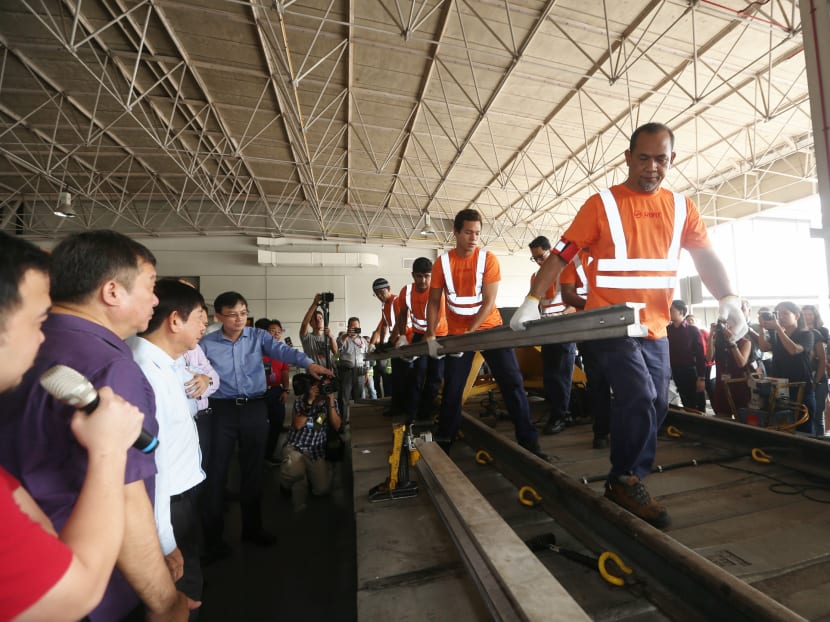Power rails on North-South and East-West lines replaced after 2-year effort
SINGAPORE — Commuters can expect fewer power faults and improved reliability on the Republic's oldest MRT lines with work to replace the “third rail” — which supplies power to trains — wrapping up on the North-South and East-West lines (NSEWL) after two years.

Coordinating Minister for Infrastructure and Minister for Transport, Mr Khaw Boon Wan (third from left, in the light blue shirt), seen here viewing a demonstration of the power rail replacement at SMRT's Bishan Depot. Photo: Koh Mui Fong/TODAY
SINGAPORE — Commuters can expect fewer power faults and improved reliability on the Republic's oldest MRT lines with work to replace the “third rail” — which supplies power to trains — wrapping up on the North-South and East-West lines (NSEWL) after two years.
Announcing the project’s completion at a ceremony at the Bishan Depot on Tuesday (Sept 12), the Land Transport Authority (LTA) and rail operator SMRT said about 180km of composite aluminium-and-stainless-steel rails have been replaced since September 2015.
This is the second major project to spruce up the 30-year-old NSEWL, after work to replace the lines’ timber track sleepers with concrete ones finished in December last year.
As part of the third-rail replacement work, the distance between brackets and rail assembly claws has also been trimmed for improved support.
More than 400 workers were involved, and work was done during engineering hours between 1.30am and 4.30am.
Third rails feed electricity into passing trains to power their motors, air-conditioning and lights. Each conductor rail had to be unbolted and removed, and a new conductor rail lowered in its place, before being reconnected to a high-voltage electricity network.
Workers replaced the final section of the power rail near Ang Mo Kio MRT Station along the North-South Line on Aug 15.
The third rail has been blamed for a number of train service trip-ups over the years. In 2015, a massive breakdown on the NSEWL, which hit an estimated 250,000 commuters, was found to have stemmed from problems with the insulation of the third rail.
Speaking at Tuesday's ceremony, Transport Minister Khaw Boon Wan reiterated that replacing the NSEWL’s core systems, including the power supply, track circuits and trains, takes many years, with completion set for 2024.
But he noted that commuters need not wait until then to see improvements in rail reliability.
“If we keep on track, each time we replace a core system, there will be a quantum leap," he said.
In Parliament on Monday, Mr Khaw said that the Government was pushing for resignalling work on the North-South Line to wrap up before December.
This is to allow more intensive tests on the new signalling system on the East-West Line to begin during the December holidays, he said on Tuesday.
Even as the focus is on the NSEWL, other lines such as the Bukit Panjang Light Rail Transit (LRT) also need attention, Mr Khaw added, as he set a new reliability target - measured by Mean Kilometre Between Failure - of 100,000 car-km between delays of more than five minutes for the line.
In the first half of this year, the Bukit Panjang LRT clocked 51,000 car-km between such delays, LTA statistics showed.
The 14-station Bukit Panjang LRT system is set to undergo an overhaul, with a tender planned to be called this year to fully replace its ageing components and upgrade its systems.








